Predaceous Diving Beetles Seeking Prey

There is a family of water beetles, Dytiscidae, known as Predaceous Diving Beetles. As their name implies, these beetles are predatory. They don’t hesitate to attack prey larger than themselves, delivering a sharp bite with their jaws to small fish, tadpoles and frogs. They then immediately inject enzymes that digest the prey so that the juices can be ingested.
Predaceous Diving Beetle larvae, called “water tigers,” are also predators, grabbing prey with their pincer-like jaws. The larvae are elongated, flattened and can be 2 inches long. They hunt by holding still, waiting with jaws wide open, and then strike suddenly, clutching the prey tightly with their jaws. As with the adults, the pincers are hollow, enabling them to begin sucking the juices of their prey while grasping it. They are often seen when they come to the surface of the water to draw air into spiracles located at the hind end of the body.
Adult Predaceous Diving Beetles are collected by young girls in East Africa. It is believed that inducing the beetles to bite their nipples will stimulate breast growth. Having recently had my toe bitten by a Predaceous Diving Beetle, I can testify that this is not a practice that most females (or males) would enjoy. (Photo: Predaceous Diving Beetle with remains of prey)
Naturally Curious is supported by donations. If you choose to contribute, you may go to http://www.naturallycuriouswithmaryholland.wordpress.com and click on the yellow “donate” button.
Predaceous Diving Beetles Remaining Active
 While meadows and fields are experiencing a sharp decline in insect life at this time of year, one habitat where insects remain active in the fall and often through the winter is ponds. Among the year-round active pond invertebrates are Predaceous Diving Beetles, which can still be observed as they row through the water, intermittently surfacing to thrust their abdomen above the water line in order to procure a bubble of air from which they breathe. Their middle and hind legs are fringed with long hairs, making them efficient at rowing through the water in search of prey or detritus to eat.
While meadows and fields are experiencing a sharp decline in insect life at this time of year, one habitat where insects remain active in the fall and often through the winter is ponds. Among the year-round active pond invertebrates are Predaceous Diving Beetles, which can still be observed as they row through the water, intermittently surfacing to thrust their abdomen above the water line in order to procure a bubble of air from which they breathe. Their middle and hind legs are fringed with long hairs, making them efficient at rowing through the water in search of prey or detritus to eat.
Predaceous Diving Beetles lay their eggs on and in plants above the waterline in early spring. When the eggs hatch, the larvae drop into the water. Mature larvae crawl out of the water to pupate in damp chambers on the shoreline. They emerge as adults and re-enter the water, where they remain active through the winter, under the ice. (Water Scavenger Beetles look a lot like Predaceous Diving Beetles, but they stroke first with one leg, then another, not simultaneously like Predaceous Diving Beetles, and they come to the surface of water head first to secure air.)
Naturally Curious is supported by donations. If you choose to contribute, you may go to http://www.naturallycuriouswithmaryholland.wordpress.com and click on the yellow “donate” button.


















What Other Naturally Curious People Are Saying